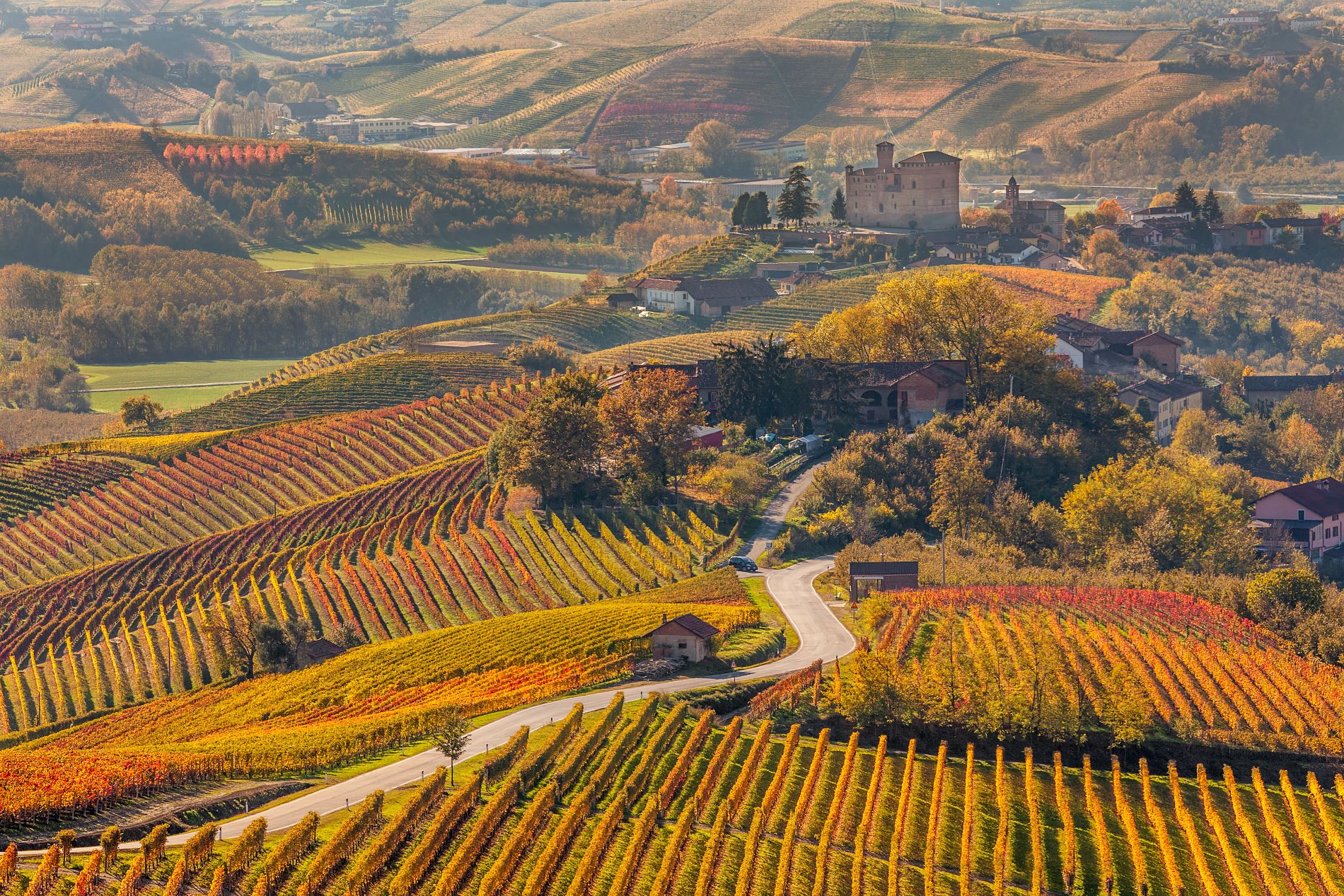Piedmont, the best region to experience in the fall
Autumn is upon us and which Italian region should we visit in the autumn months? One of our favorites is undoubtedly Piedmont. This region, located in the north-west, borders with France and Switzerland, with which it shares part of the Alps. Famous for its prestigious wines, truffles, cheeses and enchanting landscapes, Piedmont is a region that will satisfy any type of tourist.
How to reach Piedmont
Although Turin, the capital of Piedmont, has its own international airport, we always suggest to start your trip to Piedmont by landing in Milan, in Lombardy, in order to dedicate two days to the “city of fashion & design”, before starting to explore the westernmost region of Italy.
Turin
The capital is Turin, one of the most elegant cities in Italy and the first capital of the Italian Kingdom from 1861 to 1865. The city is partially crossed by the river Po, the longest river in Italy, which cuts north from Turin to Venice. For those who choose to visit Piedmont for the first time, Turin is a must.
City of nobles and sovereigns, Turin is famous above all for the beautiful residences that hosted the Savoy Royal Family and their entire court. In Piazza Castello, the heart of the city, stand the Royal Palace from where we suggest to start your city tour. Walking through the streets of the center of Turin, you will be enchanted by the noble palaces and the large squares that follow one after the other.
A particularity of this city are the colonnades that adorn the most important streets and the main squares of the city. Stop at San Carlo square, one of the most beautiful squares in the city where one of the best cafés is located (Stratta is the name) and where you can taste the chocolate symbol of the Piedmont region: the Gianduiotto.
The best places to visit in Turin:
Palazzo Reale: Designed by the architect Amedeo di Castellamonte, it was the residence of the Savoy Family until 1865. The ostentation of an architectural style reminiscent of Versailles, with the throne room, the dining and dance halls, the tapestries that cover the walls, will make you feel like you are in a dream.
The Cathedral: Adjacent to the Royal Palace is the Cathedral of Turin dedicated to St. John the Baptist. In the Cathedral, inside a chapel closed to the public, the Holy Shroud is kept. A violent fire, in 1997, partially damaged the Cathedral and its furnishings.
Mole Antonelliana: La Mole Antonelliana is a monumental building in Turin, located in the historic center, symbol of the city and one of the symbols of Italy. The name derives from the fact that, in the past, it was the highest masonry construction in the world, while its adjective derives from the architect who conceived it, Alessandro Antonelli. With a height of 167.5 meters, it was the tallest masonry building in the world from 1889 to 1908.
Museo Egizio: The Egyptian Museum of Turin is the oldest Egyptian museum in the world, founded in 1824, and second in importance only to that of Cairo. Dedicated exclusively to the art and culture of ancient Egypt, his collection has been the subject of interest by the greatest scholars of the past such as Jean-François Champollion. For this and for the importance of the collections in the museum, Turin is considered the city where Egyptology was born.
Valentino’s Park and its Royal Palace: it is the largest public park in the city of Turin and is located beside the Po river. Inside the park it is possible to admire the reconstruction of a medieval village and the royal palace of Valentino. Building of the Faculty of Architecture of the Polytechnic of Turin, the Valentino castle was conceived as a fluvial residence of the royal family, therefore originally with its entrance from the Po river side.
The Holy Shroud Museum at San Sudario Church: this church was heavily damaged during the Napoleonic period and was restored in the 20th century bringing back its beauty. If you are close to the Christian religion, it may be worth visiting the museum of the Holy Shroud which is housed in the crypt of the church. The real shroud is kept in the Cathedral of Turin and it’s not visible.
If you are interested in royal palaces there are two other important buildings of the Savoia Family, located just a few kilometers from Turin: Venaria Reale and Stupinigi.
Piedmont countryside:
Often, when someone thinks of the Italian hills rich in vineyards and historical villages, they immediately think of Tuscany. But the landscape of Piedmont is no less beautiful and rich! Just think of the wines produced in this region, to understand how important Piedmont is regarding vineyards.
Often known as “Langhe”, “Roero” or “Monferrato”, the Piedmont countryside areas are of unique beauty and its hills are protected by the UNESCO as World Heritage site.
The wines produced in those areas are among the best in Italy and famous throughout the world for their quality. Just think of Barolo, Barbaresco, Dolcetto or Nebbiolo to realize how much this region can offer.
Wine is not the sole best product of the Piedmont countryside. Another very prestigious ingredient grows right on these beautiful hills: the truffle. Considered the most expensive and prized truffle in the world, the Alba white truffle has an unmistakable flavor and it is appreciated by the greatest chefs.
And last but not least a further product of the Piedmontese countryside should be mentioned: the hazelnut. Does the name Nutella remind you of something? Piedmont is where this amazing chocolate cream was born from the Ferrero family in Alba.
That is why during a trip to Piedmont, food and wine experiences are a must to make your stay in this region unforgettable. In our itineraries through the Piedmont, visits to the most famous wineries for tours and wine tasting are always included. We also include truffle hunting experience with dinner to follow.
What to visit in Piedmont Countryside?
First of all the wine cellars. This territory is one of the richest in vineyards in Italy and a perfect destination for wine lovers. Furthermore, the countryside of Piedmont offers a series of small historic villages and small towns that will leave you spellbound. Below is a small list of places to visit.
Alba
Alba, of course, is the beating heart of this area of Piedmont. It is famous throughout the world for its great red wines, for its typical cuisine but above all because every autumn sees the International Truffle Fair Bianco d’Alba, the largest world exhibition dedicated to the “Tuber Magnatum Pico”, a unique and special ingredient for chefs and gourmets around the world. Yes, because its medieval layout – with towers and fortified houses – the Duomo and the Church of San Domenico make it a truly majestic place.
Asti
Asti, after Alba, is the second “capital” of the Langhe, home to wines and sparkling wines. Admire the Collegiate Church of San Secondo and the medieval complex of the Rotonda di San Pietro. In September, the famous palio takes place here.
Barolo
The city is known for its famous wine and not only that. The Falletti Castle, also known as the Municipal Castle of Barolo, is located in the center of the homonymous village. The Falletti marquises played a decisive part in the diffusion of Barolo wine. It was the Marchesa Giulia di Barolo who introduced him to King Carlo Alberto of Savoy, who became a great lover of it. Climb up to the top of the castle and enjoy a great view. Since 2010 Faletti Castle has hosted the WiMu, the “Wine Museum” with an innovative imprint. Furthermore, the castle cellars house the Barolo Regional Enoteca where you can taste the finest bottles.
Barbaresco
Barbaresco is a small town of just over 600 inhabitants, known for the production of the famous wine which has the same name: Barbaresco. Discover the Regional Enoteca in the deconsecrated Church of San Donato.
Grinzane
The small village of Grinzane is essentially characterized by the Castle of the Count of Cavour, who for a time was mayor of the same town. Built in the 13th century, it has undergone various architectural changes. Today it is the seat of the Piedmontese Regional Cavour Wine Cellar and an Ethnographic Museum on rural civilization.
Bergolo
It is the smallest town in the Langhe. Despite its size, it is today one of the most consolidated tourist realities in the Langhe with high quality accommodation facilities. Isolated and beautiful, it is also known as “The Stone Town” for the sandstone with which the houses are made and the paving used as paving of the streets.
La Morra
The village of La Morra rises on a very panoramic hill, among rows and rows of vines. It is one of the main centers for the production of Barolo and Nebbiolo, as shown by the many wineries in the area. On the road that connects La Morra and Grinzane Cavour you will see a work of contemporary art: the Red Giant Bench or the Bench of Serenity. The Giant Benches of the Langhe are a project of the American designer Chris Bangle to promote tourism in these areas. The idea is to change our perspective: sitting on a giant bench makes us go back to being children and watching the world with new wonder.
Piedmont and its lakes
Piedmont is a perfect destination for lake lovers. Lake Maggiore, whose name means the largest lake in Italy, is divided between Piedmont and Lombardy. This lake offers breathtaking views and wonderful villas. It is famous for its island called Isola Bella which is home to one of the most interesting historic residences in the area: the villa of the Borromeo family, one of the families that marked the history of Italy. If you are in the area, do not miss the tour of Stresa and its islands.
Winkitaly can offer day tours departing from Turin or Milan. Another lake which is worth a visit if you are in Piedmont: Lake Orta. Lake Orta is not among the most popular lakes in Italy and perhaps this is also its charm. It is surrounded by lush greenery interspersed with small towns such as Orta San Giulio, a real gem to be discovered with its enchanted central island.
Curiosity
Barolo is a red wine produced with 100% Nebbiolo grapes, and must be aged for at least 3 years, of which at least 18 months in cask. With 5 years of aging it becomes Barolo Riserva. With the “king of wines” there are no compromises: the long aging, first in wood and then in the bottle, is the way to achieve excellence!
I hope that you enjoyed this insight into the Piedmont region and that you get inspired to learn more or see for yourself! If you enjoyed this blog post, share it with a friend and if you are interested in learning more about traveling to this area or any other region in Italy, please contact us for more information.
Stay tuned for more blogs about other regions in Italy and be sure to click the link below for an example of tours we offer in the Piedmont region.





